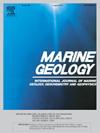安达曼海滩沉积物中的事件层- 2004年海啸记录
IF 2.2
3区 地球科学
Q2 GEOSCIENCES, MULTIDISCIPLINARY
引用次数: 0
摘要
2004年12月26日,孟加拉湾安达曼群岛沿海地区遭受了地震引发的海啸的严重影响。这项研究于2023年进行,调查了在Bada Balu, Collinpur和Mayabunder三个海滩的海沟和坑段中发现的海啸沉积物的沉积属性。已识别的海啸沉积包括基质支撑砾石砂、块状砂、基质支撑砾石有机泥、通常分级为块状砂和大砾质砾石相类型。以下部碎屑流和流动分离后产生的上部浊度流为特征的二元流是形成砾石泥或砾石砂和砂联的主要原因。巨大的沙幔覆盖在侵蚀表面上,这是由于含沙的海啸上升的减弱阶段造成的,而巨大的卵石砾石散布,以圆形巨石为特征,代表了来自新兴珊瑚礁的牵引毯沉积。沉积物组成和质地的极端变化表明,海啸波的强度及其传播方向在不同海岸带之间存在显著差异,主要受海岸形态的影响。所研究的2004年地震引发的海啸的独特沉积结构将作为解释古代记录中海啸沉积物的宝贵工具。此外,本研究建立的诊断标准可用于区分海啸和气旋风暴沉积。本文章由计算机程序翻译,如有差异,请以英文原文为准。
Event beds in Andaman beach sediments – records of 2004 Tsunami
The coastal zones of the Andaman Islands in the Bay of Bengal experienced the severe impact of an earthquake-generated tsunami on 26 December 2004. This study, conducted in 2023 investigates the sedimentary attributes of tsunami deposits found in trench and pit sections across three beaches: Bada Balu, Collinpur, and Mayabunder. The identified tsunami deposits include matrix-supported gravelly sand, massive sand, matrix-supported gravelly organic mud, normally graded to massive sand, and large bouldery gravel facies types. Bipartite flows, characterized by lower debris flows and upper turbidity currents generated after flow separation are responsible for the formation of gravelly mud or gravelly sand and sand couplets. Massive sand drapes over erosional surfaces are attributed to the waning phases of sand-laden tsunami run-up, while large bouldery gravel spreads, featuring rounded boulders, represent traction carpet deposits sourced from emerged coral reefs. The extreme variation in sediment composition and texture reveals that the strength of the tsunami waves and their propagation directions varied significantly across different coastal zones, largely influenced by coastal morphology. The distinct sedimentary structures of the studied 2004 earthquake-generated tsunami will serve as a valuable tool for interpreting tsunami deposits in the ancient record. Furthermore, the diagnostic criteria established in this study can be applied to distinguish between tsunami and cyclonic storm deposits.
求助全文
通过发布文献求助,成功后即可免费获取论文全文。
去求助
来源期刊

Marine Geology
地学-地球科学综合
CiteScore
6.10
自引率
6.90%
发文量
175
审稿时长
21.9 weeks
期刊介绍:
Marine Geology is the premier international journal on marine geological processes in the broadest sense. We seek papers that are comprehensive, interdisciplinary and synthetic that will be lasting contributions to the field. Although most papers are based on regional studies, they must demonstrate new findings of international significance. We accept papers on subjects as diverse as seafloor hydrothermal systems, beach dynamics, early diagenesis, microbiological studies in sediments, palaeoclimate studies and geophysical studies of the seabed. We encourage papers that address emerging new fields, for example the influence of anthropogenic processes on coastal/marine geology and coastal/marine geoarchaeology. We insist that the papers are concerned with the marine realm and that they deal with geology: with rocks, sediments, and physical and chemical processes affecting them. Papers should address scientific hypotheses: highly descriptive data compilations or papers that deal only with marine management and risk assessment should be submitted to other journals. Papers on laboratory or modelling studies must demonstrate direct relevance to marine processes or deposits. The primary criteria for acceptance of papers is that the science is of high quality, novel, significant, and of broad international interest.
 求助内容:
求助内容: 应助结果提醒方式:
应助结果提醒方式:


